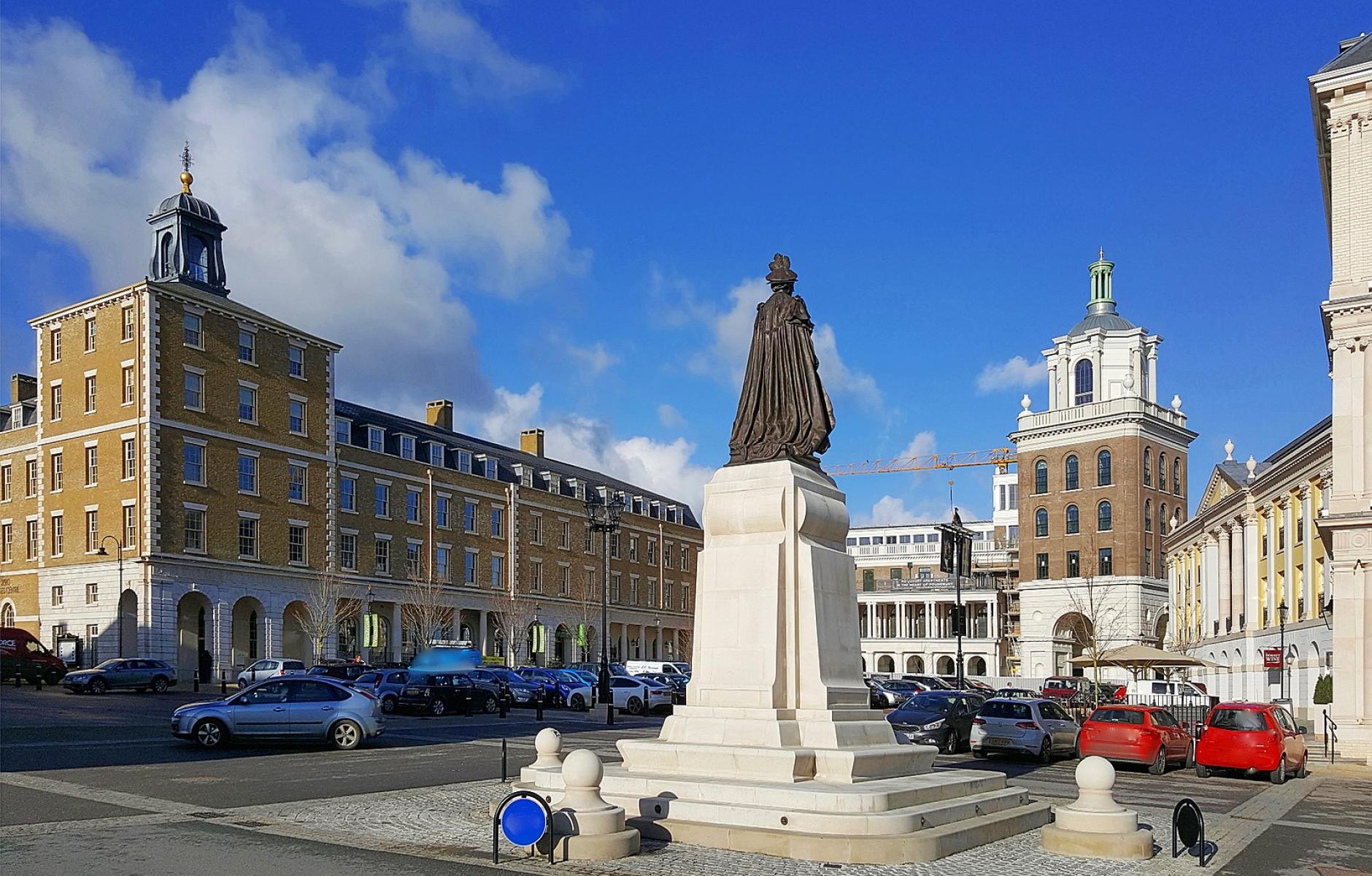
Assessing Poundbury at 30
There is a new town in England whose achievements might draw the envy of any American planner: a beautiful walkable layout with ample provisions for walking, cycling and transit as well as the car; 35 percent permanent affordable housing, “pepper-potted” indistinguishably across the town, and not clustered into identifiable “projects;” mixed use zoning, with 207 businesses integrated into the town, and providing over 2,300 jobs available to its population of 3,800; and a number of innovative ecological features. Among the latter are a net zero emissions biomethane generator that provides fuel for up to 59,000 homes; “solar slate” roof systems; electric charging stations throughout the town (installed long before they became common elsewhere); high-insulation homes using cavity wall construction with high thermal mass; and a shift away from plastics and other problematic substances, toward natural and renewable materials.
This is of course Poundbury, the experimental urban extension of Dorchester initiated by King Charles, the former Prince of Wales. When he published the popular 1980s book “A Vision of Britain,” naysayers charged that such development principles couldn’t be implemented successfully in today’s world. The Prince, they said, should stop trying to save the world of architecture, and stick to his charity polo matches. Charles set out to prove them wrong by embarking on Poundbury, and later, other similar neighborhood developments across the UK.
Poundbury, as the oldest of his developments, now offers a large body of evidence as to how well it has performed. The record is not perfect, of course – and perhaps the lessons learned are as important as the successes. Poundbury has certainly been successful as a real estate development; in fact, where early critics charged that the project was squandering Duchy assets, they later complained that the participants were making too much money from UK government assets. The Prince, it seemed, couldn’t win.
One conspicuously missing element in Poundbury, often noted by critics, is cutting-edge contemporary architecture. This is a subject for a fair debate—one hopes, moving beyond the tiresome and facile attacks on “faux” and “mock,” and into more intelligent discourse. The debate should first acknowledge that revival and recapitulation have been essential ingredients of architecture across eras and cultures—notably up until only recently—and their recycling has resulted in some of the most durable, successful, well-loved, and sustainable (for it has sustained) habitat in human history.
There is also Jane Jacobs’ insightful critique of the dangers of allowing art (including avant-garde art) to override life—resulting in neither art nor life, she said, but “taxidermy.” The first job of architectural art, she suggested, is to serve the life of the city—a job we have not been doing well enough, surely. Indeed, a credible case can be made that architecture has let itself become a product packager and marketing arm of a rather too-toxic industry. At any rate, the subject deserves a fairer debate.
Indeed, for Americans, the vitriol directed at the former Prince, by architects and others—particularly its bilious tabloid versions—often seemed bizarrely over the top. Worse, it obscured what the man actually did achieve—a remarkably diverse series of projects with remarkable successes, not only aimed at addressing problems, but offering—and implementing—actual solutions, on an impressive range of issues: soil, food, climate, health, inner-city poverty, and much else.
The issue tackled by Poundbury is, of course, the fiasco of modern urban development, and in particular, the problematic over-dependence on the car. Poundbury tackles the host of serious “externality costs” from this still-prevalent way of doing things, including emissions, social isolation, lack of exercise, stress, and hardship on those who can’t afford to, or are unable to (or simply don’t want to) drive. The problems aren’t limited to cars, but are part of a larger “drive-through lifestyle,” with all the sprawling infrastructure needed to support it—bringing with it the much higher (but mostly hidden) costs to taxpayers for services and infrastructure operation and maintenance. This “cartopia” seemed like a good idea at the outset, but somewhere along the way, it seems, we lost common sense.
There is also the growing sense that our world is getting uglier—and somehow, that ugliness is deeply related to its unsustainability. While the Prince had never suggested that a more beautiful world would automatically be more sustainable, he did suggest that the two aspects go hand in hand. It might well follow that we need to reconsider the value of beautiful architecture (including the wealth of beautiful and successful traditional precedents) in dealing also with our environmental crises—not to mention our health and well-being, and the livability of our cities, towns and suburbs. Perhaps too, what we find more beautiful is what we will better care for.
The UK has a history of new “model town” projects, and the contemporary ones have a decidedly mixed track record. Many have seemed to violate architect Christopher Alexander’s maxim that “a city is not a tree”—that is, not a functional hierarchy of neatly segregated elements—but rather, it contains a diversity of ingredients that can interact in complex, overlapping ways. (Jane Jacobs made a similar argument.) Alexander analyzed many new town projects, and showed that they were indeed “trees”—much to the detriment of the people who lived there.
Charles for one was paying attention. In fact, Alexander was a long-time adviser to the Prince, and a member of the board of his Institute for Architecture. Alexander’s complex ideas were not those of a simple stylistic traditionalist—in fact, he had a surprising theoretical influence in a remarkably diverse range of fields, including software design, wiki and Wikipedia, Agile, and others.
Alexander taught summer programs with Poundbury’s master planner, Leon Krier, who is also famous for his post-modern criticisms of architectural orthodoxy. With the Prince and his Duchy of Cornwall officials, Krier assembled a diverse group of architects and planners, and armed with their principles of connected walkability and livable traditional architecture, they started construction in 1993—the same year as the first Congress for the New Urbanism in the US.
Now, thirty years later, the community is nearing completion, and the Duchy of Cornwall, The Prince’s Foundation, INTBAU, the Congress for the New Urbanism, and UN-Habitat, are all partnering with the International Making Cities Livable (IMCL) conference series to gather at Poundbury in October of this year, and assess the many lessons. The conference theme is “The Ecology of Place: from Understanding to ACTION,” with a focus on the challenges of implementation of projects like Poundbury.
The IMCL was begun in 1985 by Henry Lennard, a Viennese medical sociologist, and Suzanne Lennard, a British architectural scholar. This year’s focus will include cutting-edge topics of environmental psychology, neuroscience, and other fascinating subjects, exploring how human beings respond to different environments – and how those environments have surprising if sometimes hidden impacts on health and well-being. Speakers will include Semir Zeki, professor of neuroaesthetics at University College London, and Cleo Valentine, doctoral researcher in the neuroscience of architecture at the University of Cambridge. Many more eminent researchers will discuss topics of human health, ecology, public space, economics, and other urban issues. (The Call for Abstracts for those interested in presenting their own work ends April 30.)
For members of the Congress for the New Urbanism, the conference offers a particularly helpful opportunity to expand international dialogue and collaboration with old and new allies, and to push the boundaries of new urban research (and practice) into fascinating—and newly promising – areas, including mathematics, physics, sociology, environmental psychology, economics, and other fields.
There will be a special focus on Poundbury’s lessons, including often-debated aspects such as its street pattern, building design, management of vehicles, design controls, and other topics. The conference will also examine and compare other similar projects, and assess their helpful lessons for a new generation of more sustainable and more livable settlements.
That includes an assessment of the current challenges, and our failures in meeting them: urban issues like loss of affordability, displacement, homelessness, rapid (too often chaotic) urbanization, fragmentation and deprivation, and the mounting impacts of these urban failures on all of us; wider issues like emissions, climate impacts, resource depletion,and environmental degradation; and also the deeper institutional challenges of governance, accountability, and the erosion of trust, in the disruptive context of rapid technological change (including the Internet, social media, and now, ominously, A.I). This is a lot to take on, of course – yet these are not separate problems, but, like the problems of any city, part of what Jane Jacobs called “an interrelated organic whole.”
In examining these many challenges, and potential solutions, we can be inspired by the visionary founder of Poundbury, and all that he has achieved—a work in progress, to be sure, but a work with enormously hopeful lessons for the future.





